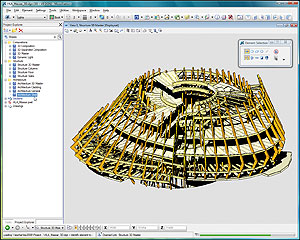Bentley has just released the latest version of its flagship product, MicroStation, along with a comprehensive portfolio of applications for infrastructure. AEC Magazine interviewed BentleyÝs chief technology officer (CTO), Keith Bentley, on the advances made in this new version, which is called V8i.
Martyn Day: The PR around MicroStation V8i claims itÝs the biggest release of MicroStation in the companyÝs history. The same was said of V8 when it was launched. What have been the challenges?
Keith Bentley: From this point on, I think each of our releases will be Ùthe biggest releaseÝ for us as we grow and make more acquisitions. One thing about this release compared to, say, MicroStation V8 XM Edition, is that while there was a lot of big stuff in V8 XM, some of its main benefits were for our applications. V8i is the companyÝs largest effort to date to get together the most programmers releasing the most code, affecting the majority of our products, being deployed by the largest number of our users.
So, it has been a concerted release with many more moving parts that all had to come together. I think our users will end up looking at V8i as a major breakpoint in the portfolio of Bentley products. In the V8i portfolio we have a lot of products that are used by a lot of people, and the products are interconnected. I donÝt necessarily expect immediate adoption of V8i, because I donÝt think overnight everyone is going to say, ÙI have to upgrade everything to V8i.Ý However, when an organisation does say, ÙNow is the time for us to move to V8i,Ý they wonÝt have anywhere near the issues they had in the past making a number of products work together. V8i is a big release for us. IÝm sure in our press communications we say this about every release, but I really do look at this release as a big one!
MD: With the release sounding like such an effort, customers may worry about the upheaval of upgrading.
KB: As you can imagine, IÝve been through a lot of releases and talked to many users about trying to encourage people to upgrade. As you know, in every software upgrade there comes some pain and some gain ± hopefully more of the latter. In V8i, I think the gain-vs-pain ratio is very high. For example, I think the pain point addressed by the ProjectWise ÙDelta File Transfer,Ý and the pain of slow file transfer that it solves, is bigger than the feature sets of a lot of previous generations. Companies can deploy V8i and literally the next day their projects are going to run much smoother. Moreover, the features and benefits in MicroStation V8i translate into profitability for our customers. WeÝre very excited about that.

MD: The MicroStation release has been boiled down to five main features: intuitive design modelling, interactive dynamic views, intrinsic geo-coordination, integrated Print Organizer, and iterative Luxology rendering. WhatÝs new, whatÝs updated, and whatÝs been licensed.
KB: I think each one has important benefits to offer our users and thereÝs a combination of new, updated, and licensed. For example, we licensed the rendering engine from Luxology. The integration of that technology with MicroStation and with our vertical applications is going to change our market in much the same way that the digital camera changed the film market.
Twenty years ago, there were professional photographers, who were very good at using a 35mm camera and at developing their own film. Photography was an art, and when you saw a really cool picture you were impressed.
Nowadays, people take a hundred pictures and if one of them turns out well they toss the other 99 and, in their minds, they are photographers. In terms of the way visualisation will be used in AEC projects, having something thatÝs directly and easily accessible to all users ± and fast ± will fill an important need. One of the key features of Luxology is that it does a really good job amazingly fast. So, like with a digital camera, I think a lot more people will use it and become good at it.
The other items in the list of features are improvements or brand new content. Take, for example, dynamic views. Most people will compare dynamic views to Revit drawing extractions or synchronisation techniques. In differentiating between what weÝve done with dynamic views and what Revit does, you need to understand that dynamic views use the same referencing capabilities that MicroStation has pioneered for a long time. The most important thing about that is the biggest downside with Revit: When youÝre trying to keep your drawings in synch with your model, it all has to be stored in one place ± youÝre always facing a limit of how big a project can be or how distributed a project can be. With MicroStation, you can subdivide the project whatever way you want and have as many files as you like. And with V8i, weÝve taken the best of both worlds.

If youÝre in a session of MicroStation and have, say, 30±40 files that are all being referenced, and you need to edit some of them, in the past with MicroStation and AutoCAD there was one lock on one file. Now we can modify multiple files and have a transaction that spans multiple, independently lockable files. This is a big thing. You can have a large project spread across multiple offices and multiple computers and files.
MD: Tell me a bit more about the new conceptual modelling tools ¾ what have you done there to expand MicroStationÝs capabilities?
KB: We recognise that there are some incredible opportunities for using GenerativeComponents with other modelling tools: drawing modelling, component modelling, parametric modelling, even sketchy-type modelling tools. The cool thing is, we have made them all work together. In V8i, our objective was to make it so that in a distributed team, where people focus on aspects of the project using each of those techniques, when everyone comes together to collaborate, their work is all shared in DGN files.
In the past, weÝve had people spending resources using a tool like SketchUp. SketchUp is a great tool, and itÝs been used by a number of our users. People say to us, ÙCanÝt you make SketchUp work better with MicroStation?Ý and, yes, we do a pretty decent job of importing and exporting SketchUp files. But, weÝre going to make those people much more productive by enabling them to use the powerful referencing, raster, point cloud, etc. tools in MicroStation. In other words, they can now use in their conceptual modelling, all the features that drive their decision to pick MicroStation for their engineering project.
From an interface perspective, the goal was to make V8i easy to learn and use, for the people who say, ÙI donÝt want to learn MicroStation,Ý or ÙI donÝt want to install every application on my desktop; I just want to use SketchUp.Ý So we focussed on coming up with ways that you can use MicroStation and turn off all the features you donÝt care about and just use it in a simplified way. Similarly, for users of GenerativeComponents, in MicroStation they are going to find themselves in that nice, easy environment, sketching in 3D mode, until they get to the point where they want to add more precision and use some feature modelling. Once theyÝve crossed into the solid modelling world, then they can use solid modelling techniques.
With V8i, with improved DGN referencing techniques, it will all seem pretty seamless. The two main scopes of our company ¾ comprehensive and integration ¾ are coming together in this world of design modelling.
{mospagebreak}

MD: Is V8i the first version based on a new foundation? Or are the foundations still being built?
KB: No, V8i is the first version based on the XM foundation. A lot of our modelling tools, structural analysis tools, and building energy analysis tools have releases that are part of our V8i rollout. In fact, we now have the biggest array of solutions in the AEC industry ± literally. I think thereÝs a lot more to the Bentley V8i release than Autodesk has in all of its AEC products put together.
Plus, it all works together. In fact, we created something called the interoperability platform. In reality, that mostly happened in the XM release. So in XM, we started taking the parts of MicroStation, the parts of ProjectWise that are shared across lots of other applications, creating this programming tool kit that many programmers can use. But in XM, it really wasnÝt deployed very well ± there wasnÝt much that you could hold out as being of benefit for the user. But in V8i, a lot of our products incorporate the engineering interoperability platform.
So is V8i the first release on the new platform? V8i is actually the second release of the new platform. But when we got XM together, we didnÝt have enough time to put any real meat behind all those new techniques and subsystems, beyond just getting it to work as it did before.
The platform was born in the generation that created XM, but most of our products didnÝt roll out on it. The XM generation spanned multiple releases of MicroStation and our vertical products.
MD: You called V8i the integration platform for your vertical products. Could you explain a bit more what this means?
KB: Yes. I referred earlier to the interoperability platform that now exists in the V8i platform. One reason it exists is that when newly acquired companies would come to us and ask, ÙNow that weÝre a part of Bentley, where do we go to download the integration tools that we use to do this or that?Ý we didnÝt have a simple answer to their question.
Frankly, every time we did an acquisition I was embarrassed by the involved explanation for how they could integrate with our other products. Everyone in a newly acquired company typically is very enthusiastic about being a good corporate citizen and just wants to know what they need to do to become one. Our answer before V8i was: ÙIt ainÝt that easy.Ý Now we have a solution.
MD: Are you happy with Windows Vista as being a steady platform for CAD, or is it still an incredibly overweight, fat, system-hungry? What about 64-bit?

KB: I think Vista has a bad reputation now, which frankly isnÝt really deserved. I hate to be labeled as a Microsoft sycophant because there are a lot of things that I wish theyÝd do better. But, for MicroStation, Vista is the best choice.
Perhaps the biggest problem weÝve had is switching from OpenGL to Direct3D, which we didnÝt necessarily have to do, but we did. Direct3D under XP can perform poorly when the user has two screens ¾ and a lot of MicroStation users have two screens. If you switch to Vista, the dual-screen support is definitely better. The 64-bit debate is two years out of date now. On a 64-bit operating system, MicroStation can take advantage of a lot more of the extra addressable memory. At this point, if youÝre configuring a new computer, there arenÝt really many reasons to install the 32-bit operating system. With the 64-bit version, you wonÝt run into as many problems with big models. Of course, with small models it doesnÝt matter, but the distinction between small and big changes every year.
MD: The DWG/DGN announcement with Autodesk was probably the biggest announcement to hit the industry since CAD was invented. Obviously, it hasnÝt made it into V8i because the announcement happened so late in the development cycle; but what timeframe are you going to be slipping that in?
KB: The Open Design Alliance (ODA) toolkit that we use now does a pretty good job of emulating a lot of whatÝs in AutoCADÝs DWG format. Actually, the concept mismatches between MicroStation and DWG are now fairly few. Converting to Real DWG really isnÝt as big a job to implement engineering-wise, but it certainly will require a lot of testing. WeÝve put a lot of work into making sure that when youÝre editing a DWG file in MicroStation, youÝre editing the MicroStation content and keeping all the DWG content updated concurrently.
I would guess youÝre going to see us implement AutodeskÝs Real DWG in a 2009 release of V8i.
MD: Have you handed to Autodesk your MicroStation API in return?
KB: Yes. They have our library, and we have theirs.
MD: Do you have no fear about what theyÝre going to attempt do with the DGN access?
KB: I think we recognise that they are going to be able to do as good a job with DGN as they want to. So file formats will not be either our or their differentiator. If anything, I think good DGN support in AutoCAD might be an advantage for us and our users. The MicroStation user will have the enviable luxury of saying, ÙHereÝs your DGNÝ when they work with other people who have AutoCAD.
MD: So have you relinquished your membership in the ODA?

KB: No, we are still members of the ODA. We still use their library; in fact, weÝre still shipping it today. Yes, weÝre going to replace the DWG library that we use in MicroStation, but weÝre still a member of the ODA. We support them in their creation of the Open DGN libraries that they have developed from our published DGN specification documents.
MD: WhatÝs the future of the ODAÝs Open DGN format now?
KB: We answer the ODAÝs questions, but they donÝt get any source code from us. We merely give them documentation about the format.
MD: ThereÝs a lot of talk about cloud computing. Is there a space for CAD and Bentley in this cloud service based world?
KB: I think there will be, specifically some of the analysis type applications that arenÝt particularly interactive. I donÝt necessarily think that most of what people think of as ÙCADÝ applications will translate into cloud computing very well. But analysing data that you create, and even some data that you use in that model (e.g., environmental conditions), can be done via shared ÙcloudÝ resources. The theory of shared computing resources is old, but I think itÝs the future as well.
MD: BentleyÝs Enterprise clientele and subscription models are very different from AutodeskÝs volume play. Moving forward, is this likely to fundamentally change?
KB: BentleyÝs business model is an important factor in how we go about creating products and the way in which we target acquisitions. Our model is based on long-term relationships. Our subscriptions model is part of our DNA. WeÝre really motivated by things that marry us to users and make it a win-win.
If people using our products are successful, they are more likely to continue to subscribe to our programs so they can get more enabling technology through us. Our Enterprise License Subscription has been one of the most successful things weÝve done in the last ten years.
If you want to predict the way in which Bentley will go, weÝre focused on an ever-increasing scope of Ùthings that people use when designing, building and using infrastructureÝ.
WeÝre not necessarily looking for license revenue; weÝre looking for ways to partner with people and make them more successful.






